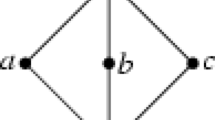Abstract
MV-algebras as well as orthomodular lattices can be seen as a particular case of so-called “basic algebras” which are an alter ego of bounded lattices whose sections are equipped with fixed antitone involutions. The class of basic algebras is an ideal variety. In the paper, we give an internal characterization of congruence kernels (ideals) and find a finite basis of ideal terms, with focus on monotone and effect basic algebras. We also axiomatize basic algebras that are subdirect products of linearly ordered ones.


Similar content being viewed by others
Explore related subjects
Discover the latest articles, news and stories from top researchers in related subjects.Notes
Almost nothing—in fact, the intersection of basic algebras and BL-algebras are MV-algebras. Indeed, if \(\langle A;\vee ,\wedge ,\odot ,\rightarrow ,0,1\rangle \) is a BL-algebra, then for each \(a\in A\), the map \(\varphi _a:[a,1]\rightarrow [a,1]\) defined by \(\varphi _a(x)=x\rightarrow a\) is antitone, but it need not be an involution. The \(\varphi _a\)’s are involutions only if the BL-algebra satisfies the law of double negation, i.e., if it is (equivalent to) an MV-algebra.
At first glance, this might seem to be a misprint, but we do mean “p-ideals”, not pre-ideals. It can happen that a pre-ideal of an orthomodular basic algebra is not a p-ideal (or even a lattice ideal) of the corresponding orthomodular lattice (see Krňávek and Kühr 2011).
References
Botur M, Halaš R, Kühr J (2012) States on commutative basic algebras. Fuzzy Sets Syst 187:77–91
Chajda I, Halaš R (2008) Varieties of lattice effect algebras generated by 4-element members. Acta Sci Math Szeged 74:49–64
Chajda I, Kolařík M (2009) Independence of axiom system of basic algebras. Soft Comput 13:41–43
Chajda I, Halaš R, Kühr J (2009a) Many-valued quantum algebras. Algebra Univers 60:63–90
Chajda I, Halaš R, Kühr J (2009b) Every effect algebra can be made into a total algebra. Algebra Univers 61:139–150
Cignoli RLO, D’Ottaviano IML, Mundici D (2000) Algebraic foundations of many-valued reasoning. Kluwer, Dordrecht
Dalla Chiara M, Giuntini R, Greechie R (2004) Reasoning in quantum theory: sharp and unsharp quantum logics. Kluwer, Dordrecht
Dvurečenskij A, Pulmannová S (2000) New trends in quantum structures. Kluwer, Dordrecht
Dvurečenskij A, Vetterlein T (2001) Pseudoeffect algebras II: group representations. Int J Theor Phys 40:703–726
Foulis D, Bennett MK (1994) Effect algebras and unsharp quantum logics. Found Phys 24:1331–1352
Gumm HP, Ursini A (1984) Ideals in universal algebra. Algebra Univers 19:45–54
Hájek P (1998) Metamathematics of fuzzy logic. Kluwer, Dordrecht
Kalmbach G (1983) Orthomodular lattices. Academic Press, London
Kôpka F, Chovanec F (1994) D-posets. Math Slovaca 44:21–34
Krnávek J, Kühr J (2011) Pre-ideals of basic algebras. Int J Theor Phys 50:3828–3843
Pulmannová S, Vinceková E (2009) Congruences and ideals in lattice effect algebras as basic algebras. Kybernetika 45:1030–1039
Ravindran K (1996) On a structure theory of effect algebras. PhD thesis, Kansas State Univ., Manhattan
Acknowledgments
This research has been supported by the ESF project no. CZ.1.07/2.3.00/20.0051 “Algebraic Methods in Quantum Logic”.
Author information
Authors and Affiliations
Corresponding author
Rights and permissions
About this article
Cite this article
Chajda, I., Kühr, J. Ideals and congruences of basic algebras. Soft Comput 17, 401–410 (2013). https://doi.org/10.1007/s00500-012-0915-4
Published:
Issue Date:
DOI: https://doi.org/10.1007/s00500-012-0915-4





